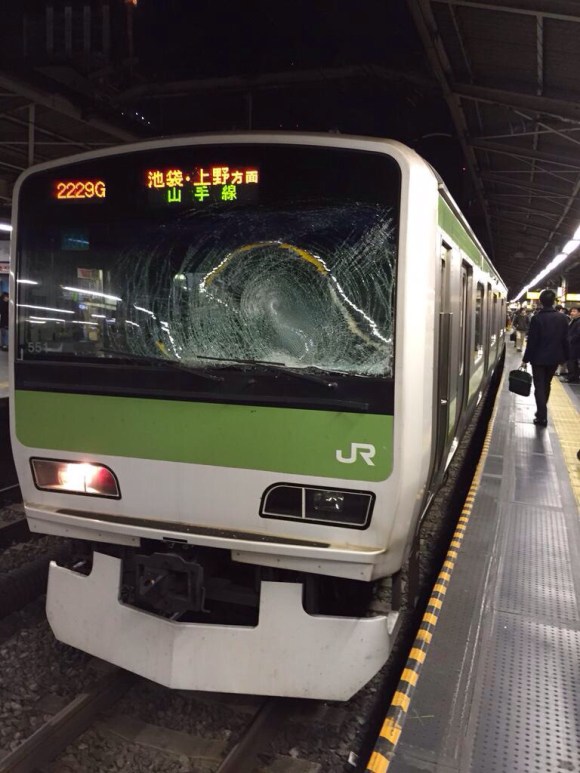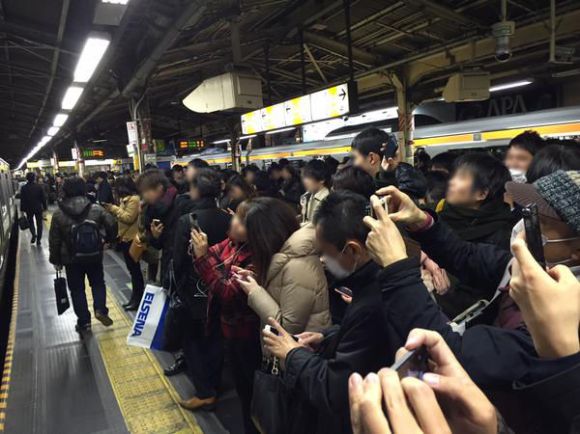Picture the scene: You’re out late one night, waiting to catch your train home. Finally it rolls up to the platform, its front window caved in, cracks spider-webbing through the glass. That’s when you hear the announcement: due to a human-involved accident, operations have been suspended.
You know what’s happened. But how do you react? Do you gape in shock? Do you find it too upsetting to even look at and avert your eyes?
Or maybe you whip out that phone of yours to snap a picture, just like this group of onlookers at Shinjuku Station in Tokyo.
If you’ve lived any amount of time in Japan and frequently use the trains, you’ve probably become quickly familiar with the term jinshin-jiko, which literally as “human accident”. While this is a pretty vague term that can mean an accident involving a person resulting in injury or death, most take it to mean that someone has intentionally leapt in front of an oncoming train, which is often the case.
Maybe hearing about these accidents all the time leaves people desensitized to the reality of the situation. Perhaps, living in the age of the smartphone, we all instinctively feel the need to document the events that unfold before us no matter what they are. Looking at all the indifferent faces in the crowd of bystanders as they brandish their phones and snap pictures, it seems to be a mixture of the two.
Clearly at least one person – the uploader of the above photo – felt that the sight of so many taking a snap of a train whose window had been smashed in by the body of a fellow human being was more than a little distasteful. A sentiment shared by number of online commenters:
“There’s nothing as despicable as these rubberneckers.”
“Then they probably uploaded it to Twitter or something. Japan is finished.”
“I wouldn’t want to keep that sort of picture on my phone. I would want to get away from there as fast as possible, I wouldn’t even want to breathe the air.”
“These guys are disgusting, probably proudly showing off their photos.”
“I hope the person who died curses those guys taking pictures with their phones.”
However, there are still some who don’t really see any issue with taking a quick snap of the impactful sight:
“What an annoying way to kill yourself; let them publicize it.”
“Even in other countries, if there’s an accident people take pictures and post it to the internet like this too.”
“If I was there I would definitely take a picture too.”
It is true that suicide in Japan is still a considerable problem, being the leading cause of death of men ages 20-44. According to OECD Health Data released in 2011, the suicide rate in Japan took a noticeable jump in the late ’90s, and has stayed significantly above other countries like Switzerland, New Zealand, and Norway, whose rates have either remained steady or dropped during the same period.
Like one of the above commenters, commuters in Tokyo especially often voice their disdain and annoyance for people who choose to end their life by jumping in front of a train, particularly if it makes them late for work. Personally, this is something that is difficult to get my head around. If this is still such a frequent problem, perhaps more action needs to be taken to address the cause, work towards a solution, and offer help to those who have found themselves in such a low place that they feel suicide is their only option.
It’s hard to say how I would react if I had seen something like that in person, but I certainly hope I never have to find out.




 Artistic Japanese website AI has a long way to go before it can appropriately rate user’s Pikachu pics
Artistic Japanese website AI has a long way to go before it can appropriately rate user’s Pikachu pics This is the absolute worst train to fall asleep on in Tokyo…or wait, maybe it’s the best?【Pics】
This is the absolute worst train to fall asleep on in Tokyo…or wait, maybe it’s the best?【Pics】 Japan may add Japanese language proficiency, lifestyle classes to permanent foreign resident requirements
Japan may add Japanese language proficiency, lifestyle classes to permanent foreign resident requirements Lacquerware supplier to emperor of Japan and Pokémon team up for new tableware
Lacquerware supplier to emperor of Japan and Pokémon team up for new tableware Is it rude to sing along at concerts in Japan? We ask a pro musician for his take
Is it rude to sing along at concerts in Japan? We ask a pro musician for his take Our reporter takes her 71-year-old mother to a visual kei concert for the first time
Our reporter takes her 71-year-old mother to a visual kei concert for the first time Large amount of supposed human organs left in Osaka marketplace
Large amount of supposed human organs left in Osaka marketplace Disillusionment at Tsukiji’s tourist-target prices led us to a great ramen restaurant in Tokyo
Disillusionment at Tsukiji’s tourist-target prices led us to a great ramen restaurant in Tokyo Online shop’s anime character personal seals look awesome, can be used for legal paperwork
Online shop’s anime character personal seals look awesome, can be used for legal paperwork Kyoto samurai house wants to share its history of seppuku, torture and gold coins with visitors
Kyoto samurai house wants to share its history of seppuku, torture and gold coins with visitors Is this the most relaxing Starbucks in Japan?
Is this the most relaxing Starbucks in Japan? Kit Kat taxis blessed by Shinto priest offer good luck to test-taking passengers
Kit Kat taxis blessed by Shinto priest offer good luck to test-taking passengers 7-Eleven Japan starts new temporary luggage storage service in over 300 branches
7-Eleven Japan starts new temporary luggage storage service in over 300 branches Starbucks teams up with 166-year-old Kyoto doll maker for Year of the Horse decorations【Photos】
Starbucks teams up with 166-year-old Kyoto doll maker for Year of the Horse decorations【Photos】 Tokyo’s Tsukiji sushi neighborhood asks tour groups to stay away for the rest of the month
Tokyo’s Tsukiji sushi neighborhood asks tour groups to stay away for the rest of the month Starbucks Japan releases new zodiac chilled cup drink for 2026
Starbucks Japan releases new zodiac chilled cup drink for 2026 Street Fighter Hadouken Churros to be launched and eaten in Tokyo, Okami pudding on offer too
Street Fighter Hadouken Churros to be launched and eaten in Tokyo, Okami pudding on offer too Starbucks on a Shinkansen bullet train platform: 6 tips for using the automated store in Japan
Starbucks on a Shinkansen bullet train platform: 6 tips for using the automated store in Japan Japan’s human washing machines will go on sale to general public, demos to be held in Tokyo
Japan’s human washing machines will go on sale to general public, demos to be held in Tokyo Japanese train company is letting fans buy its actual ticket gates for their homes
Japanese train company is letting fans buy its actual ticket gates for their homes Tokyo considering law requiring more trash cans following litter increase in heavily touristed area
Tokyo considering law requiring more trash cans following litter increase in heavily touristed area Is China’s don’t-go-to-Japan warning affecting tourist crowds in Tokyo’s Asakusa neighborhood?
Is China’s don’t-go-to-Japan warning affecting tourist crowds in Tokyo’s Asakusa neighborhood? Nintendo’s Kirby now delivering orders at Kura Sushi restaurants, but not in Japan
Nintendo’s Kirby now delivering orders at Kura Sushi restaurants, but not in Japan Tokyo event lets you travel back in time, for free, to celebrate 100 years since Showa era start
Tokyo event lets you travel back in time, for free, to celebrate 100 years since Showa era start Survey asks foreign tourists what bothered them in Japan, more than half gave same answer
Survey asks foreign tourists what bothered them in Japan, more than half gave same answer Japan’s deadliest food claims more victims, but why do people keep eating it for New Year’s?
Japan’s deadliest food claims more victims, but why do people keep eating it for New Year’s? We deeply regret going into this tunnel on our walk in the mountains of Japan
We deeply regret going into this tunnel on our walk in the mountains of Japan Studio Ghibli releases Kodama forest spirits from Princess Mononoke to light up your home
Studio Ghibli releases Kodama forest spirits from Princess Mononoke to light up your home Major Japanese hotel chain says reservations via overseas booking sites may not be valid
Major Japanese hotel chain says reservations via overseas booking sites may not be valid Put sesame oil in your coffee? Japanese maker says it’s the best way to start your day【Taste test】
Put sesame oil in your coffee? Japanese maker says it’s the best way to start your day【Taste test】 The top 10 annoying foreign tourist behaviors on trains, as chosen by Japanese people【Survey】
The top 10 annoying foreign tourist behaviors on trains, as chosen by Japanese people【Survey】 No more using real katana for tourism activities, Japan’s National Police Agency says
No more using real katana for tourism activities, Japan’s National Police Agency says Starbucks Japan reveals new sakura drinkware collection, inspired by evening cherry blossoms
Starbucks Japan reveals new sakura drinkware collection, inspired by evening cherry blossoms
Leave a Reply